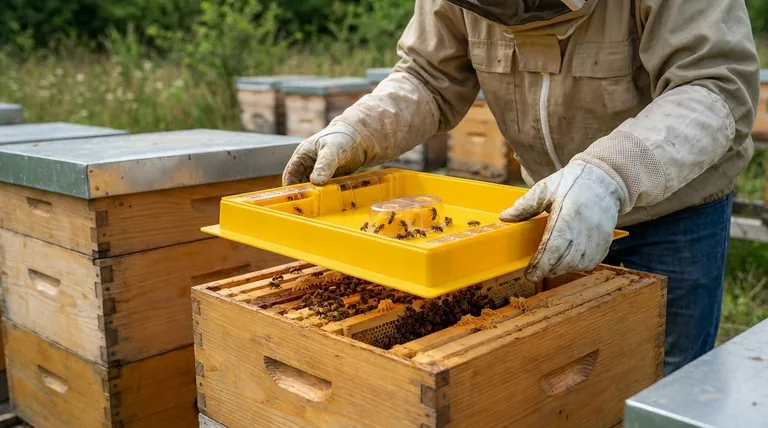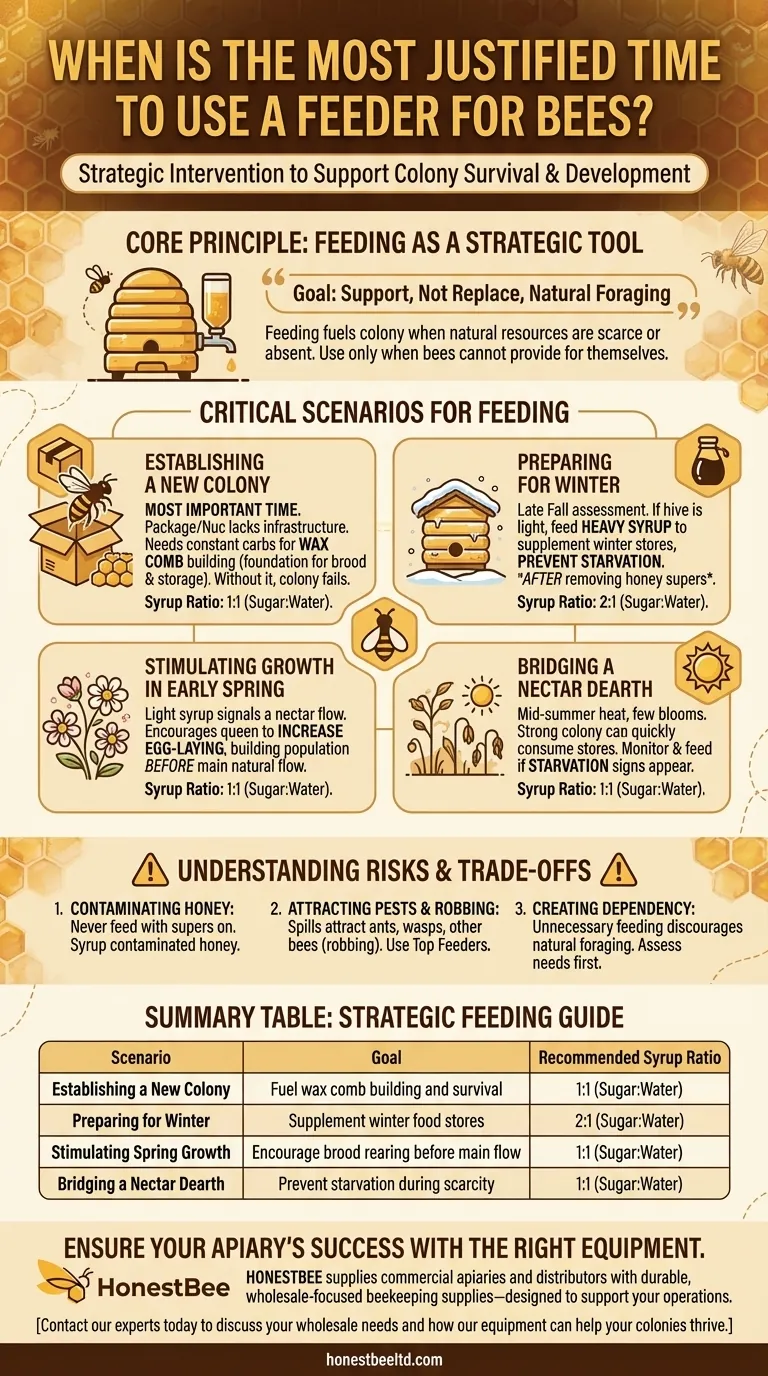The most justified time to use a bee feeder is when a colony lacks the natural resources necessary for its immediate survival and development. This is most critical when establishing a new colony, especially from a package, as the bees start with absolutely no stored food, comb, or pollen. Feeding in this scenario directly fuels their ability to build a sustainable home.
A beekeeper's goal is to support a colony's natural foraging, not replace it. Feeding is a strategic intervention used only when the bees cannot provide for themselves, ensuring their survival during periods of vulnerability or scarcity.

The Core Principle: Feeding as a Strategic Tool
A healthy, established bee colony is a self-sufficient superorganism. However, beekeepers can use feeding as a targeted tool to help a colony overcome specific challenges it cannot handle on its own.
Why Bees Need Supplemental Food
Bees forage for nectar and convert it into honey to power all hive activities. When there is no natural nectar available, a colony can starve. Supplemental feeding with sugar syrup provides the raw carbohydrates they need to survive these gaps.
Mimicking a Natural Nectar Flow
The presence of incoming "nectar," whether real or from a feeder, stimulates specific behaviors in the hive. A light, steady flow encourages the queen to lay eggs and workers to build wax comb, while a heavy flow encourages them to store food for the future.
Critical Scenarios for Using a Feeder
While there are several situations that call for feeding, a few stand out as non-negotiable for responsible beekeeping.
Establishing a New Colony
This is the most important time to feed. A package of bees or a small nucleus colony has no established infrastructure. They need a constant supply of carbohydrates to draw wax comb, which is the essential foundation for raising brood and storing food. Without this initial support, the colony will likely fail.
Preparing a Colony for Winter
In late fall, you must assess if your hive has stored enough honey to survive the cold months when they cannot forage. If the hive feels light, feeding a heavy syrup is critical to supplement their winter stores and prevent starvation. This feeding must be done after you have removed any honey supers intended for human consumption.
Stimulating Growth in Early Spring
Feeding a light syrup in early spring can act as a signal to the queen that a nectar flow has begun. This encourages her to increase her egg-laying rate, building up the colony's population before the main natural nectar flow starts. A larger workforce can then gather significantly more resources during the peak season.
Bridging a Nectar Dearth
A nectar dearth is a period, often in the heat of mid-summer, when few plants are blooming. During a dearth, a strong colony can quickly consume its stored honey. If the dearth is prolonged, feeding may be necessary to prevent the colony from starving or absconding.
Understanding the Trade-offs and Risks
Strategic feeding is beneficial, but improper feeding can cause significant harm. Understanding the risks is essential for making the right decision.
The Risk of Contaminating Honey
Never feed your bees while honey supers are on the hive. Bees will store the sugar syrup in the comb just as they would nectar, contaminating the honey you intend to harvest. This results in a low-quality product that is not pure honey.
Attracting Pests and Robbing
Spilled syrup or poorly designed feeders can attract ants, wasps, and bees from other hives. This can trigger "robbing," where a stronger colony attacks a weaker one to steal its resources, often resulting in the death of the weaker colony. Top feeders are often preferred as they are contained within the hive, minimizing this risk.
Creating Dependency
Constant, unnecessary feeding can discourage a colony's natural foraging instincts. The goal is to supplement, not replace, their own hard work. Always assess the hive's needs and the availability of natural forage before deciding to feed.
Making the Right Feeding Decision
Your reason for feeding will determine how and when you do it.
- If you are installing a new package or nuc: Feed a 1:1 sugar-to-water syrup consistently until the bees have built out the comb on most frames in their first brood box.
- If you are preparing a colony for winter: Feed a heavy 2:1 sugar-to-water syrup in the fall only after you have removed your honey supers and if the hive feels light.
- If you want to boost a weak colony in early spring: Provide a light 1:1 syrup to stimulate brood rearing, but stop as soon as natural nectar becomes widely available.
- If you are in a summer nectar dearth: Monitor the hive's food stores and feed a 1:1 syrup only if they show signs of starvation.
Thoughtful feeding is a sign of a proactive beekeeper, transforming a simple tool into a powerful instrument for colony health and survival.
Summary Table:
| Scenario | Goal | Recommended Syrup Ratio |
|---|---|---|
| Establishing a New Colony | Fuel wax comb building and survival | 1:1 (Sugar:Water) |
| Preparing for Winter | Supplement winter food stores | 2:1 (Sugar:Water) |
| Stimulating Spring Growth | Encourage brood rearing before main flow | 1:1 (Sugar:Water) |
| Bridging a Nectar Dearth | Prevent starvation during scarcity | 1:1 (Sugar:Water) |
Ensure your apiary's success with the right equipment. Proper feeding is just one part of effective hive management. HONESTBEE supplies commercial apiaries and beekeeping equipment distributors with durable, wholesale-focused beekeeping supplies—from feeders and hive tools to protective gear—designed to support the health and productivity of your operations.
Contact our experts today to discuss your wholesale needs and how our equipment can help your colonies thrive.
Visual Guide

Related Products
- Professional Hive Top Bee Feeder for Beekeeping
- Rapid Bee Feeder White Plastic 2L Round Top Feeder for 8 or 10-Frame Bee Hives
- HONESTBEE Round Hive Top Bee Feeder for Syrup
- HONESTBEE Entrance Bee Feeder Professional Hive Nutrition Solution for Beekeeping
- Classic Boardman Entrance Bee Feeder Hive Front Feeding Solution
People Also Ask
- What types of hive boxes is the round hive top feeder compatible with? Universal Fit for 8 & 10-Frame Langstroth Hives
- Do I need an inner cover with a hive top feeder? Optimize Your Hive Setup for Healthy Bees
- How is the plywood floor fitted into the hive-top feeder? Ensure Longevity with a Floating Floor Design
- What are the features of top feeders for bees? Maximize Hive Health with Safe, High-Capacity Feeding
- Why is a top feeder essential for bees? Ensure Colony Health and Efficiency



















